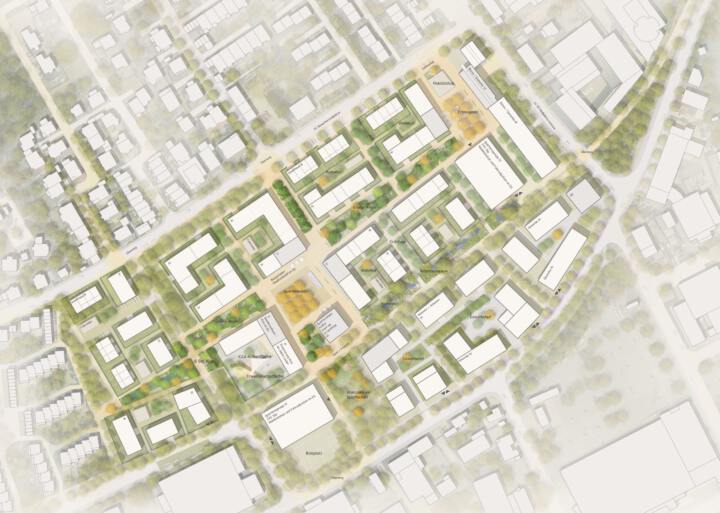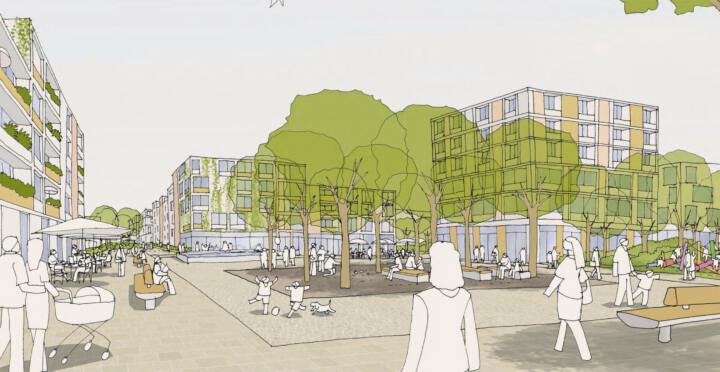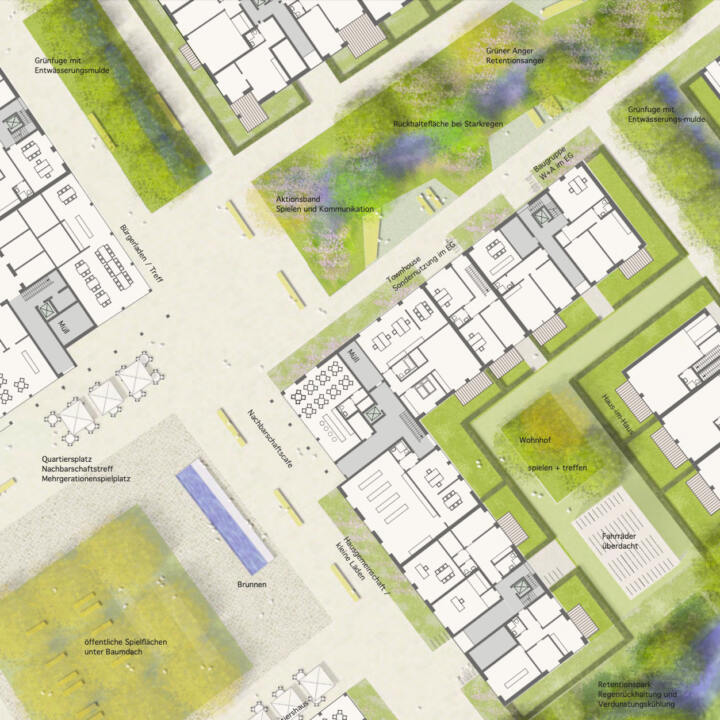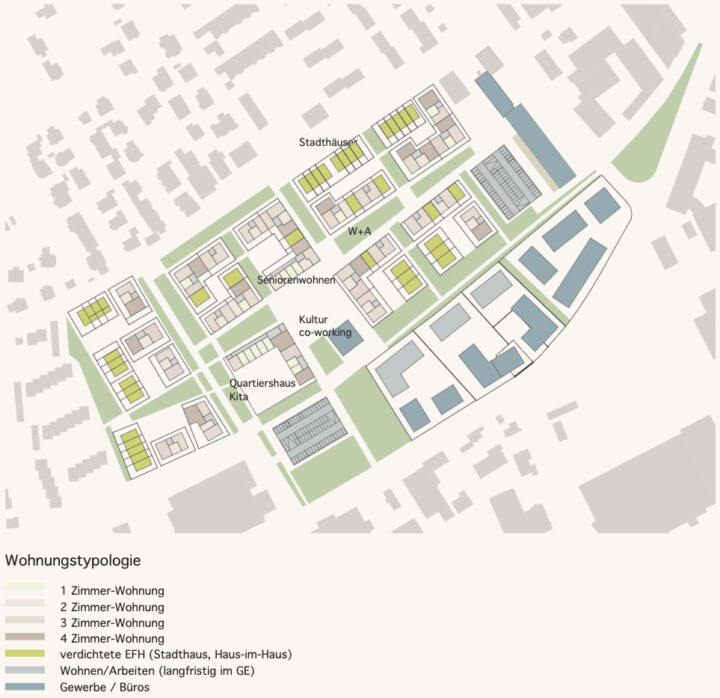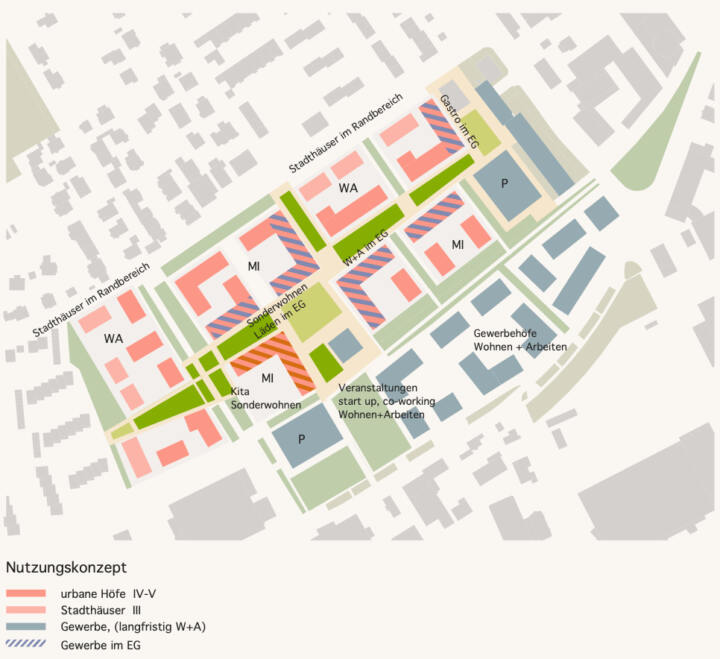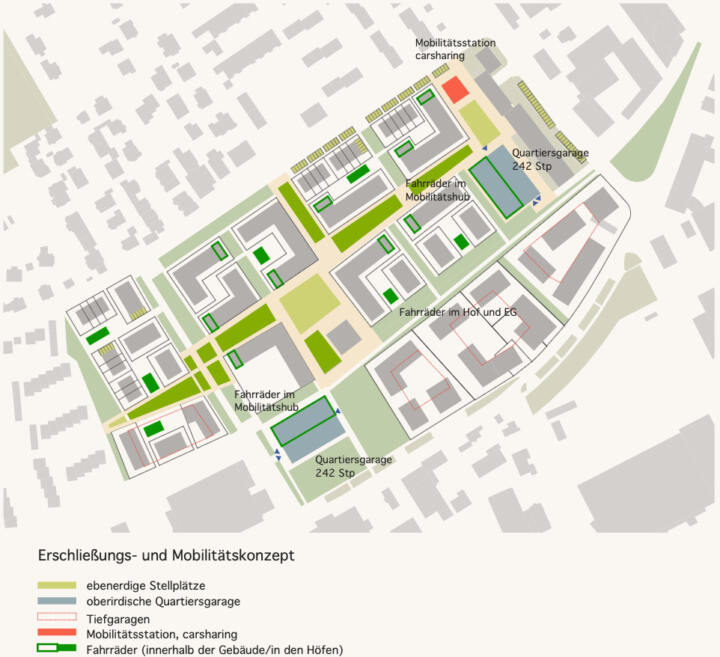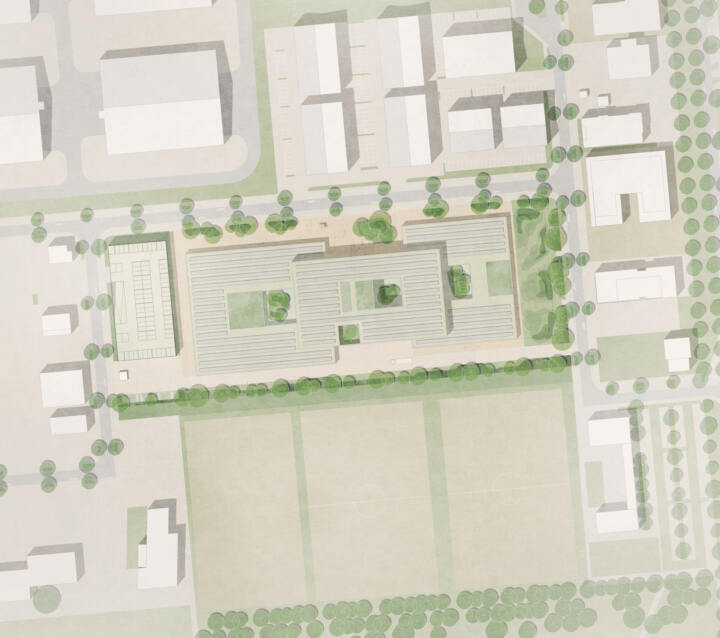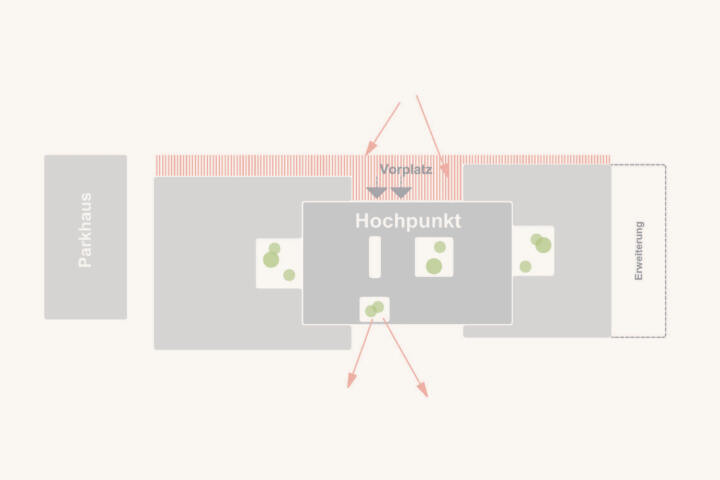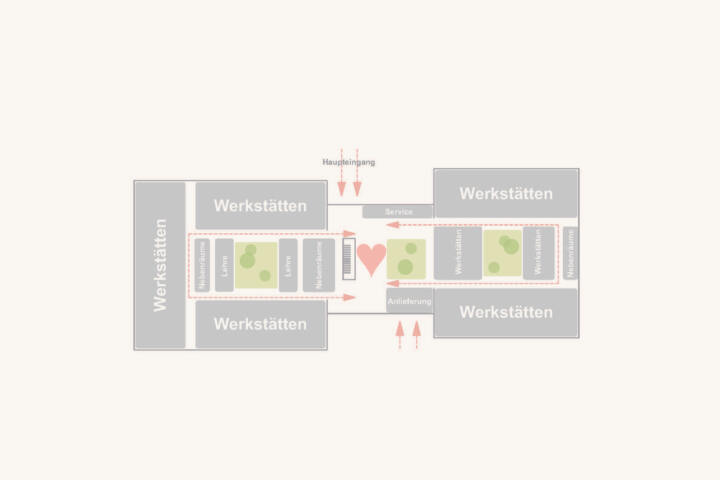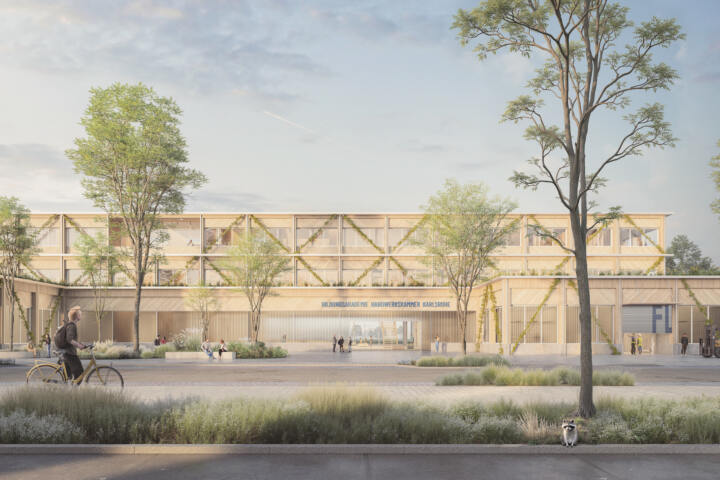Former Telecommunications Office | Heusenstamm
1st Prize | Former Communications Office
Heusenstamm
In collaboration with Thomas Schüler Architekten und Stadtplaner
Urban development concept
The urban development concept builds on the adjacent urban fabric and forms an independent urban building block that mediates between the northern residential areas and the southern commercial area.
As an urban-style neighbourhood, new forms of living are emerging here that combine living and working and create a new type of sustainable urban neighbourhood for Heusenstamm on individual plots. The extensive greening of public spaces creates an all-round open-space interconnection and a green stepping stone to the adjacent landscape areas.
Open space backbone and neighbourhood structure
The new neighbourhood will be accessed via a central open space backbone, which the individual building plots will be based on and from which they will receive their addresses. This open space, as an ‘urban green space’, forms an attractive inner green corridor and connects all areas of the neighbourhood, promoting identification and community within the new urban neighbourhood.
This creates a high quality of living throughout the entire interior area with communal spaces for playing, meeting and spending time. Recesses and widenings create different spatial situations and give rise to an exciting internal structure.
The ‘green common’ functions as a communicative communal open space with play and recreation areas for all generations.
Partially shaded by a mixed canopy of climate-resilient tree species, the green space integrates meeting places, outdoor fitness facilities and play areas. A subtle relief with hollows absorbs some of the surface and roof water and, in addition to the changing image of dry and temporarily wet areas, creates a mosaic of different location factors that promise a highly diverse species composition.
Green joints divide the new residential quarter into clearly legible individual building plots and provide clear orientation and address formation. At the same time, they make the quarter permeable, enable a variety of crossings and ensure connection to the existing cycle and footpath networks.
Development concept
The concept envisages building plots with open courtyard structures that can be developed in sections as independent neighbourhood areas. They form a robust urban framework for a mixed-use urban neighbourhood, with a coexistence of residential, working and commercial uses. Flexible development for multi-storey residential buildings, townhouses or houses-within-houses with different living and working models will be created on various individual plots.
The building plots will be developed with individual detached houses, contributing to a lively, small-scale neighbourhood image. The result will be a flexible mix of different typologies for subsidised and privately financed housing.
Small ground-floor commercial units, communal areas and living+working spaces face the ‘urban green space’ and enliven the public space. The impetus provided by the building groups is being used here to strengthen the character of the neighbourhood with its mixed working and living models.
The residential courtyards support the idea of communal living, with play areas and places for communication. As green inner courtyards, they contribute to well-being and function as green oases with a high quality of living. Green living areas, residential gardens with large trees and self-sufficient gardens on the roofs form further communal areas within the building groups.
This clear and robust framework creates the conditions for small-scale construction development with a maximum of individual freedom. A few typological specifications will create the basic structure for a new urban quarter – integrated into the urban space and flexible for new living concepts.
Central square as a calling card
At the intersection of the path axes, the neighbourhood square is created, which can serve as a hub for urban life. It forms the heart of the new neighbourhood and serves as a place of communication between the residents of the adjacent districts and the new neighbourhood. Here there are play and communication areas for all age groups and open-use areas for community events. A small fountain forms a central and invigorating element on the square.
The central neighbourhood house is being built directly on the square, symbolising the architectural centre as a solitary landmark. It will house cultural and commercial uses, co-working and innovative office space for start-ups. A gallery café enlivens the public space and acts as an urban magnet.
Adjacent to this is the neighbourhood centre with a daycare centre and a multi-generational house above it. The neighbourhood meeting place and community shop will enliven the striking corner of the northern construction site. Above these are special types of housing for senior citizens with various care services.
Climate protection and climate adaptation
All trees worth preserving will be retained and supplemented with new tree plantings. The current and future tree population can thus continue to serve as a source of fresh and cool air. The open construction method provides bioclimatic relief and improves ventilation conditions.
Within the neighbourhoods, too, generous tree planting in squares and residential streets will provide sufficient shade and thus contribute to improving the microclimate. The greening of inner courtyards, extensive façade greening and the greening of roof areas will ensure maximum cooling and evaporation effects.
Traffic and mobility
The car parking spaces are distributed across two neighbourhood garages located centrally within the individual construction phases. Access is via the adjacent road space, with traffic taking a short route to the neighbourhood garage. The entrances to the garages face the squares, creating communicative spaces. The base houses a mobility station and parking spaces for bicycles.
The central mobility hub is located at the entrance plaza, a pavilion with a bicycle repair shop and all the functions required for the concept of ‘soft mobility’, such as car-sharing spaces, rental bicycles and charging stations for electric vehicles. Intelligent mobility and sharing concepts in combination with public transport can significantly reduce moving and stationary vehicle traffic. The footpaths and cycle paths through the green spaces reinforce the permeable internal access concept and promote individual walking and cycling.
The residential environment is kept free of traffic and is only accessible to residents, refuse collection and emergency vehicles when necessary. This creates a largely traffic-free interior area with high-quality open spaces, which in turn creates a vibrant neighbourhood with a high quality of life. Understated and well-placed street furniture enhances the quality of public spaces as places for people to meet and communicate.
Rainwater concept
A differentiated, decentralised rainwater management system in three stages is proposed for drainage. In the first stage, the roof water is retained via retention roofs and a large proportion of it evaporates on the roof via green roofs, which has a significant cooling effect on the area.
The remaining and greatly reduced portion of the roof water, as well as the runoff from the very limited paved areas in the inner courtyards, is retained via open ditches and gutters and in the slightly lowered lawn depressions, where it partially seeps away. In addition, if proven to be economically viable, water from private areas can be collected in decentralised retention cisterns, retained on the property and used for grey water purposes.
Rainwater from public roads and squares is also collected in a network of small ditches and open gutters and, in a first step, fed into the slight depressions within the Green Anger and the green joints. In the event of heavy rainfall, these hollows flow into the retention area on the southern edge. Due to the long retention time of the water in the green hollows, some of the water can evaporate or seep away into the vegetation areas.
Tree trenches ensure that the collected surface water from the squares supplies the trees with water.
The topic of rainwater management is made visible and tangible as an ecological quality and adaptation to climate change, contributing to the positive image of the settlement.
Economic efficiency/recycling
The primary goal is to reuse demolition materials, e.g. as recycled concrete in a hybrid construction with timber. The buildings are constructed using recyclable materials and are energy self-sufficient. The waste-to-energy concept is also intended to contribute to a natural cycle of recyclable materials in which no waste is generated.
The planning is based on recurring dimensions and takes into account uniform standards in all areas. This creates the conditions for an element-based construction method with a high degree of prefabrication, which is particularly useful in the field of timber construction. The aim is to save as much energy as possible with as few technical measures as possible, to conserve resources and to make maximum use of them.
Children's Centre, educational campus Rainbrunnen | Schorndorf

Recognition | Children’s centre, educational campus Rainbrunnen
Schorndorf
In collaboration with Atelier 30
Urban integration and interlocking with the landscape
The new children’s house with the extension of the school building on the Schorndorf educational campus is a scaled ensemble of individual buildings with a common centre, the future communicative heart of the new buildings. In the context of the existing buildings, these form an arrangement in a free network that interlocks with the open spaces and offers well-proportioned open spaces.
The school extension for the Fröbelschule is connected to the new building in a natural way. The kindergarten will have its own separate entrance in the southern part of the site. The design concept of interlocking landscape and building is also reflected in the interior of the ensemble. The orderly structures of the buildings create very well-organised interior sequences and exciting spatial relationships from the inside to the outside and vice versa. These characteristics make the new building an emblematic, varied and creative building for children and teachers. Another important aspect of the concept was to locate the uses in recognisable structures, whereby the extension to the school complements and strengthens the existing campus concept and its facilities.
Outdoor facilities
Arrival
The start of the new school and kindergarten day takes place on the forecourt. Planted with a multi-stem, generously planted amber tree with a round bench hovering around the tree, the entrance plaza is both a passageway and a recreation area. The western part of the forecourt along the lay-by and in front of the main entrance offers generous space for waiting, boarding and alighting, while the eastern part extends the open space in front of the dining hall, offers space for the playing field to be relocated and extends the existing playground of the Fröbelschule to the east.
Play yards
The positioning of the buildings allocates clearly defined open spaces to the individual kindergarten and school areas. A linear play sculpture with integrated sand play, climbing and retreat options and a slide closes off a western play yard to the property boundary and arranges the play options in such a space-saving way that there is plenty of room for romping and dashing and for a bobby car track outside the fall protection area. The northern play yard in the spatial context of the Christian Morgenstern School is designed as an exercise yard with a range of play equipment adapted to the age group. The school garden with its opportunities for barrier-free gardening and outdoor lessons is located in the north-east courtyard.
Ecological aspects
We see the open space on the entire site as a heavily greened play and school landscape. It is covered by large-crowned future trees and structured by sunken areas of grasses and shrubs which, in addition to their insect-friendly abundance of flowers, also serve as retention and seepage areas. The paved recreation areas are paved with permeable concrete paving, with linear grass paving at the edges. All shrub plantings around the edges are planted with native trees and shrubs and a border of native wild herbs to protect birds. Where no playable and walkable lawn area is required, lean, double-cut meadows make their contribution to biodiversity. In addition to aesthetic considerations, all planting is carried out in such a way that it can make a valuable contribution to biodiversity. Through a targeted selection of different substrates, a mosaic of ecologically valuable sites is initiated, which develops into particularly species-rich plant communities through the sowing of native wild herb seeds. Modelling the terrain into shallow depressions for retention and infiltration further increases the diversity of the microsites.
Water management and biodiversity
In addition to the requirements of the exercise and learning landscape, the open spaces also fulfil fundamental functions of resilient and sustainable area development. These include a maximum of structurally rich vegetation areas, water-permeable surface paving and rainwater management as a circulation system. The roof surfaces of the school building are designed as retention roofs (approx. 20-40 cm of substrate and retention boxes) to optimise rainwater retention and evaporation. The substrate layer in combination with the retention boxes stores the rainwater and makes it available to the plants. In the ground-bound vegetation areas, the rainwater is channelled to the planting areas through the formation of the topography.
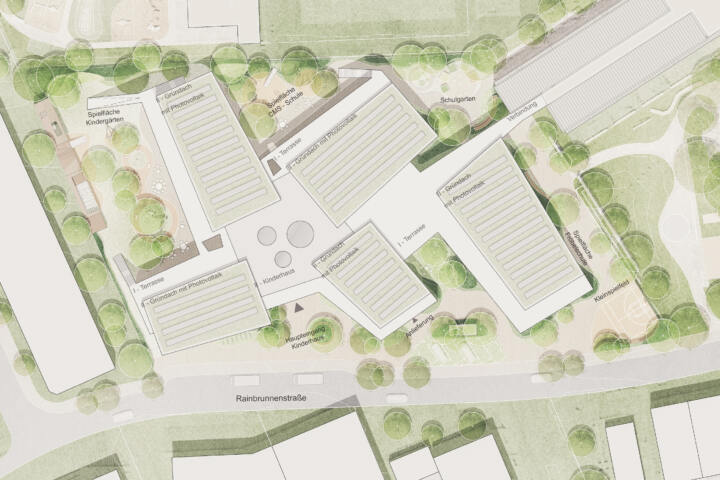


Daycare Centre Hegge | Waltenhofen
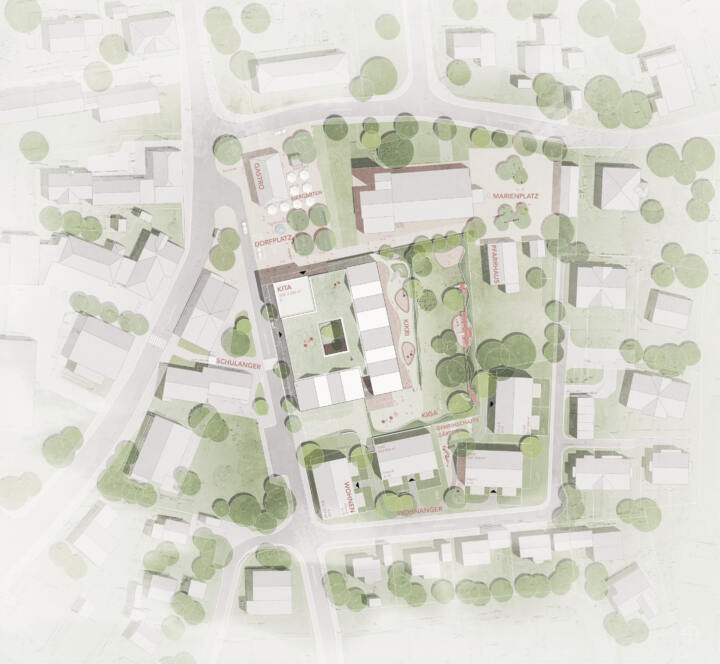
2nd Price | Daycare Centre Hegge
Waltenhofen
In collaboration with Benkert Schäfer
Local spatial setting and integration into the surroundings
The district of Hegge is characterised by open development without spatial densification towards the centre. Peripheral zones have been densified by residential development, while the centre lacks a place for the community. The new day care centre is intended to resolve this tension and seize the opportunity to create a new centre. The proposed location of the new daycare centre in the immediate vicinity of the church and local supermarket will reorganise the village centre and create a lively village square. In order to bring the church back to life on the village square, buildings that are no longer necessary will be removed. The deliberate placement of trees divides the new village centre into different areas of use. A small pub with a beer garden and shady areas invite people to linger. A cooling fountain improves the microclimate, especially on hot summer days. The new daycare centre itself is an open house for the children on the village square. With a sequence of paths and squares, it continues the village square inside and allows the different uses of the daycare centre to be experienced. The building makes clever use of the local topography – the multi-purpose room directly at the entrance is an address and open to the whole community, while the kindergarten and other communal uses are organised around a shared inner courtyard at the centre of the building. The crèche for the youngest children is organised in the plinth below, with direct access to the garden. An open and rhythmic setting in the scale of the surrounding buildings is proposed for the residential building. Following the principle of the clustered village, small outdoor areas are created that can be used communally.
Access and traffic
The main access to the daycare centre is via the village square and Veitser Straße. Kiss & Ride car parks will be created along the road to ensure that children can be picked up and dropped off safely. Access to the garden to the south and east and an entrance from Veitserstrasse, as a link to the day-care centre opposite, round off the connection with the surrounding area. Parking for daycare centre staff and residents of the new residential development is provided in the shared underground car park, which is also accessed from Veitser Strasse. Additional parking spaces for short errands in the village centre are located to the north of the village square along Industriestrasse. The residential street ‘Am Pfarrgarten’ will therefore remain largely reserved for residents and thus offers quiet access to the individual residential buildings via the shared green. A new footpath connects the village square with Marienplatz and creates a direct pedestrian axis for the residents of the eastern ‘Illerbogen’ area. The entrance to the new daycare centre is located on the village square, where there is also covered bicycle parking – creating a meeting place for teachers, parents and children. The kitchen will be delivered via an additional entrance on Veitser Straße.
Typology and spatial organisation
The two-storey day care centre blends harmoniously into the existing hillside location. The entrance area and the foyer with multi-purpose room are located on the ground floor, facing the centre of the village square. The general area with kitchen and dining room as well as the kindergarten are accessible from there. The large exposed seating staircase in the foyer leads to the garden level below and, in addition to providing access, also serves as a reading staircase and library.
An atrium in the centre of the building provides sufficient lighting and offers further sheltered outdoor areas for the children. The crèche is located on the garden floor with direct exits to the toddler play area in the garden. The workroom and studio are centrally located and have their own outdoor area in the atrium. The staff area is also located on the garden floor, with its own exit to the outdoor seating area. The underground car park, storage area and ancillary rooms are economically located on the slope side of the garden level.
Orientation towards the open space
All of the daycare centre’s group rooms face south-east towards the garden. The children in the kindergarten can access the garden via an external staircase in the south of the building or barrier-free via the lift. Various play areas and a large play element await them there. The area of the former parish garden will be integrated into the new play area. The younger children in the crèche have direct access to the garden via their group rooms. The outdoor area of the staff area leads via an atrium to a small terrace.
Outdoor facilities
The open space of the new day care centre creates a lively, green environment,
that blends harmoniously into the existing village structure. The preservation of the existing trees creates a natural atmosphere, provides shade and makes a valuable ecological contribution. Careful modelling of the topography creates varied outdoor areas that take up the natural terrain formation. A multifunctional play element structures the space, serves as a separation between the areas and at the same time promotes the children’s motor skills. It integrates additional storage areas for outdoor play equipment. The nursery and crèche areas are clearly defined by targeted planting, while terrace-like open spaces allow flowing transitions between indoor and outdoor areas. This creates a well thought-out. This creates a well thought-out combination of nature, play and community that optimally supports the educational use of the outdoor space.
Sustainability
The new daycare centre in times of climate change – sustainable, economical and climate-neutral
In the construction sector, and therefore also for cities and municipalities, there is a growing responsibility to focus on sustainable concepts when realising new buildings. The building proposed here is therefore sustainable, economical and forward-looking.
TOPOS and open space – sustainable inner-city development is climate-resilient and can adapt to climate change through blue-green settlement strategies. Green roofs and, in some cases, green façades reduce heat loss and improve the microclimate through absorption cooling in summer. A house tree and retention areas in the inner courtyard support these measures. Rainwater can be retained on site via cisterns, utilised and excess precipitation can seep away in soakaways on the property
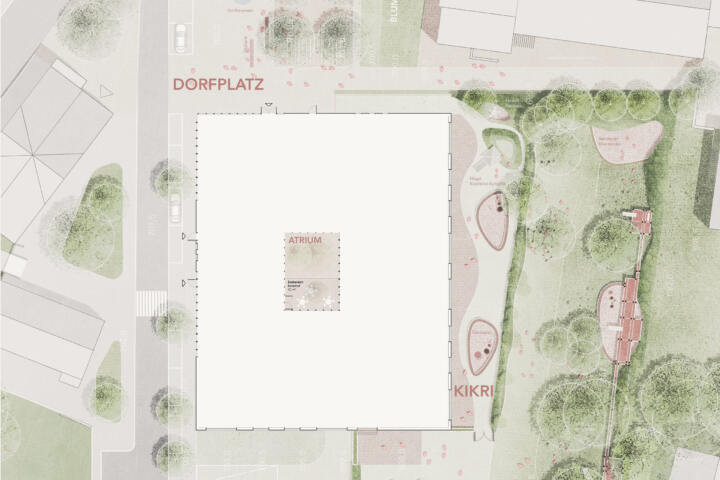

New Construction of the Training Academy Chamber of Crafts Karlsruhe | Karlsruhe
Recognition | New Construction of the Training Academy Chamber of Crafts Karlsruhe
Karlsruhe
In collaboration with Atelier30
Urban planning idea
The new training academy gives the Karlsruhe Chamber of Crafts the opportunity to present itself in the context of constant economic, technological and social change with a new, contemporary and modern learning and working environment.
In accordance with planning and building regulations, the new building will be positioned along Johann-Georg-Schlosser-Straße. By staggering the structure, the building volume is structured and functionally organised.
The main entrance to the building is located in the centrally positioned, striking three-storey section of the academy, giving the educational academy an easily recognisable appearance that is appropriate to the location.
An entrance square is located in front of the main entrance, providing a short link between the car park at the side and the main entrance.
Inner courtyards
The workshops are arranged around central courtyards. This creates a varied circulation area with interesting views when moving through the workshop areas. In addition, widened areas in front of the courtyards and the courtyards themselves offer space for communication and relaxation.
Open space
The Bildungsakademie in Karlsruhe is reached via a spacious forecourt. Past small green islands and numerous trees, the entrance is clearly recognisable. A combination of greenery and seating areas creates an attractive place to meet and offers the opportunity to spend time in the urban centre under shady trees.
The collective relocation of the car parks to the western part of the site creates a calmer area in front of the academy for pedestrians and cyclists. This is reinforced by bicycle parking spaces in front of the entrance.
Deliveries are made via the southern open space. Together with the entrance to the petrol station, deliveries can take place separately from the rest of the Academy’s use. A strip of vegetation in combination with a fence restricts accessibility and creates a clear spatial separation. To further enhance this area, however, numerous trees will be planted. Small niches with seating areas are created under this tree canopy in combination with extensions of the green belt.
A central point in the outdoor area planning is the increasingly important rainwater management in order to ensure that the educational academy remains a modern location for many years to come. Generous retention and infiltration areas were therefore planned.
To the south of the new building, the retention area is located in a combination of several troughs. This allows excess rainwater from the site and neighbouring areas to be collected, evaporated and seeped away.
A green belt around the car park deck also allows some of the rainwater in the western part of the site to be absorbed. The remaining water is channelled into the long infiltration area to the south.
The three inner courtyards with green and seating elements also support the handling of precipitation through direct infiltration areas.
Roof and façade design
The roofs of the single-storey building areas and the storey ceilings of the central building are planned as timber-concrete composite ceilings on a construction grid of 5x5m. If required, the construction grid can be extended to 7.5×7.5m or 10x10m and the construction supported by beams.
The façade elements and interior walls are planned in timber frame construction.
The materiality of the façade continues the timber construction method. The façade surfaces are clad with timber panelling. Greenery is proposed for parts of the façade.
Biodiversity and rainwater management
In addition to the functional requirements of the educational academy, the open spaces also fulfil fundamental functions of resilient and sustainable area development. Rainwater management, water-permeable surface paving,
vegetation areas rich in structure, biodiversity and cohabitation take centre stage here.
centre stage. The building roofs will be intensively greened with regional seeds. The 30 cm thick substrate layer retains rainwater almost completely through storage and evaporation. Excess rainwater from the roofs is collected in cisterns and made available as service water for the building services and the green areas.
The outdoor areas are provided with a comprehensive rainwater management system. For this purpose, the rainwater is channelled into the planting or shrub areas so that it can be collected there and seep away locally. Excess rainwater during heavy rainfall events is channelled into retention areas.
The open green spaces, with a large proportion of species-rich flowering zones, with heat-tolerant extensive shrubs and grasses, serve as food and habitat for bees and insects. Free-growing hedges of native trees and shrubs are planned along the edges; they form the boundary of the space, reduce noise and provide protection. Interspersed fruit trees increase the biodiversity of the open space. A green space for people, animals and plants.


